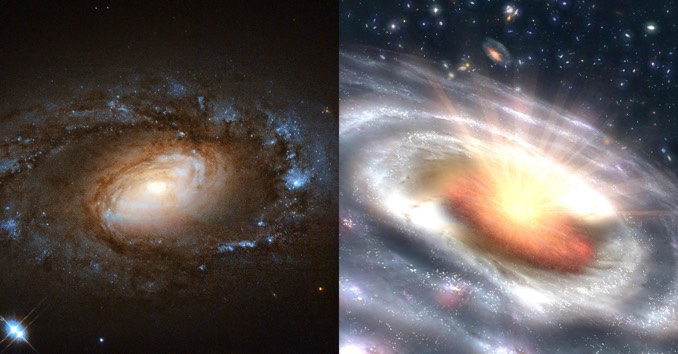
Galaxies are such enormous structures that major changes occur over extreme timescales. But astronomers have identified six previously mild-mannered galaxies that suddenly transformed into voracious quasars, erupting in feeding frenzies powered by supermassive black holes.
“It’s surprising that any galaxy can change its look on human time scales,” said Sara Frederick, a graduate student at the University of Maryland and lead author of a paper in The Astrophysical Journal. “These changes are taking place much more quickly than we can explain with current quasar theory.
“It will take some work to understand what can disrupt a galaxy’s accretion structure and cause these changes on such short order. The forces at play must be very extreme and very dramatic.”
Galaxies come in a variety of shapes, size and brightness, ranging from low-key “ordinary” star swarms to super-luminous active galaxies, or quasars, that host supermassive black holes at their cores and emit torrents of radiation as they consume surrounding gas and dust.
In between those two extremes are low-ionisation nuclear emission-line region, or LINER, galaxies, which account for about one third of all nearby galaxies. Astronomers have debated whether the light from LINER galaxies is produced primarily by star-forming regions outside the nucleus or weakly active black holes in their cores.
Frederick and her colleagues observed six “mild-mannered” LINER galaxies with the Zwicky Transient Facility at Caltech’s Palomar Observatory in California as part of a project to learn more about what causes differences in the output of Seyfert galaxies, which all feature bright nuclei.
“For one of the six objects, we first thought we had observed a tidal disruption event, which happens when a star passes too close to a supermassive black hole and gets shredded,” said Frederick. “But we later found it was a previously dormant black hole undergoing a transition that astronomers call a ‘changing look,’ resulting in a bright quasar. Observing six of these transitions, all in relatively quiet LINER galaxies, suggests that we’ve identified a totally new class of active galactic nucleus.”
Suvi Gezari, an associate professor of astronomer at UMD and a co-author of the paper describing the observations said “theory suggests “a quasar should take thousands of years to turn on, but these observations suggest that it can happen very quickly. It tells us that the theory is all wrong. We thought that Seyfert transformation was the major puzzle. But now we have a bigger issue to solve.”



